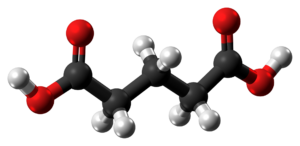Glutaric Acid Formula
Glutaric Acid
Glutaric Acid Formula- It is an organic compound that has five simple carbon linear dicarboxylic acid. Also, the body produces it during the metabolism of some amino acids that include tryptophan and lysine. When the glutaric acid is present at sufficiently high levels then it can act as a metabotoxin and an acidogenic.
Glutaric Acid Formula and Structure
The chemical formula of glutaric acid is

Biochemistry of Glutaric Acid
Naturally, the body produces glutaric acid during the metabolism of some amino acids that include tryptophan and lysine. In addition, defects in this metabolic pathway can lead to a disorder called glutaric aciduria, where toxic byproducts build up and can cause severe encephalopathy.
Production of Glutaric Acid
We can produce glutaric acid by the ring-opening of butyrolactone with potassium cyanide to provide the mixed potassium carboxylate-nitrile that is hydrolyzed to the diacid.
An alternative method is a hydrolysis that is followed by oxidation of dihydropyran that gives glutaric acid. We can also prepare by reacting 1, 3-dibromopropane with sodium or potassium cyanide to acquire the dinitrile followed by hydrolysis.
Properties of Glutaric Acid
It appears as a colorless crystal or white solid. Also, its boiling point is
However, glutaric acid is soluble in water and freely soluble in absolute alcohol, ether, benzene, chloroform, and sulfuric acid. In contrast, it is slightly soluble in petroleum ether. It has a density of 1.4
Uses of Glutaric Acid
We prepare 1, 5-Pentanediol that is a common plasticizer and a precursor to polyesters by hydrogenation of glutamic acid and its derivatives. In addition, we use glutaric acid itself in the production of polymers such as polyamides, and polyols.
Also, the odd number of the carbon atom that is 5 is very useful in decreasing the polymer elasticity. Moreover, we get uvitonic acid by the action of ammonia on glutaric acid.
Glutaric Acid Health and Safety Hazards
It can cause irritation to the eyes, respiratory tract, and skin. The compound has an acute/chronic effects like it is harmful by inhalation, ingestion, or skin absorption.
Also, when heated to decomposition it may emit acrid smoke, toxic fumes of carbon dioxide, and carbon monoxide, and irritating fumes. If someone inhales it then it can also cause sore throat and cough also it touches the skin or eyes then it causes redness and pain in the area. Its ingestion can cause abdominal pain.
Solved Example for You
Question: Explain the structure of glutaric acid?
Solution: The formula of
The carbon atoms at the beginning and end are attached to two oxygen atoms by electron sharing one of these oxygen atoms share electrons with a hydrogen atom at both ends.
In addition, all the carbon atoms are aligned with each other by sharing one electron with each other. The middle three carbon atom share their remaining two electrons with 2 hydrogen atom to acquire stability.